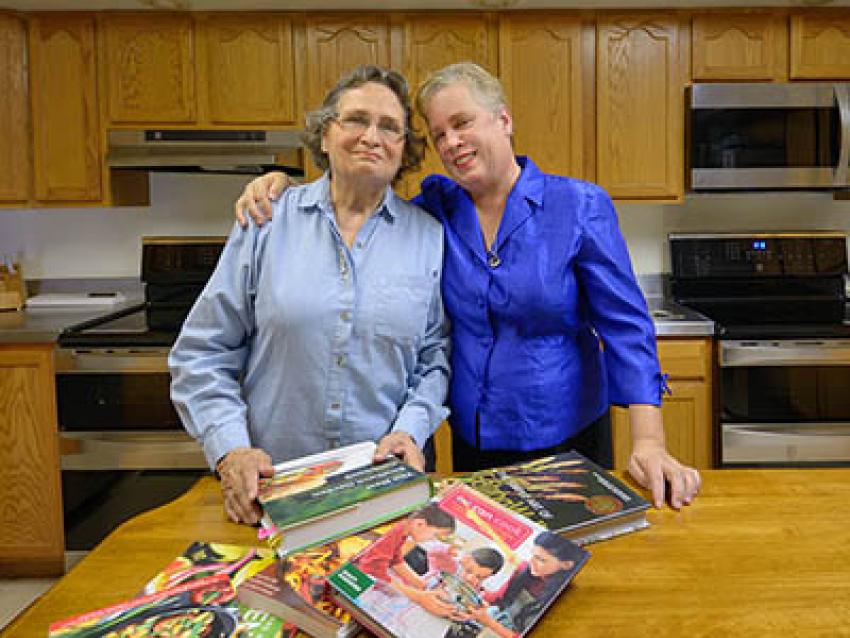
Appalachian Residents Adopt Heart-Healthy Eating Habits through Cooking Intervention
Mary Stevens of Jackson County attends heart-healthy cooking classes with her mother Betty.
West Liberty resident Bonnie Burton describes her husband as a “meat-and-potatoes” eater who shuns broccoli and other green vegetables.
So it was with some skepticism that she presented him with a meatless, three-bean chili, a recipe she learned during a recent heart-healthy cooking course hosted at the Morgan County extension office. She expected her husband to pick through the soup, scouring his bowl for some semblance of beef. To her astonishment, he didn’t need much coaxing to finish the veggie-based meal — he actually gave it his seal of approval.
Burton enjoys cooking for her husband Marvin, a cancer survivor and pre-diabetic patient. With Marvin’s health concerns now influencing the family’s diet, Bonnie Burton proceeds with caution in the kitchen, cutting out sodium when possible and scrutinizing the nutrition labels of items at the grocery store. She never needed a class to teach her how to cook well, but the free monthly class available at her extension office gives her a fresh take on cooking within new health parameters.
“I know how to cook, but there’s always room for improvement,” Burton, 66, said.
Burton and about 180 other cooks in six Eastern Kentucky counties are practicing heart-healthy cooking techniques through their participation in the REACH (Rural Eating and Healthy Cooking) program. Hosted at each county’s local Cooperative Extension office once or twice a month, the classes take participants through the process of planning and cooking nutritious, budget-friendly meals using practical ingredients they can obtain in their local communities. The University of Kentucky College of Nursing and the UK College of Agriculture, Food and Environment Department of Family and Consumer Sciences collaborated on the project, and are collecting qualitative and quantitative data on strategies to initiate dietary behavior.
During the classes, participants are given tools, such as vegetable peelers, to encourage healthy cooking at home. Participants also receive the American Heart Association’s official heart-healthy cookbook free of charge. Instructors guide participants through each step of making a specific meal from the cookbook. After class, participants take the meal home, where they have the option to replicate it for their families. Study participants send the research team their grocery receipts each month for measuring changes in fruit and vegetable intake and, saturated fat intake.
Through REACH, UK nursing professor Frances Hardin-Fanning, the principal investigator on the study, hopes to gather valuable information about overcoming the various environmental barriers that hinder healthy eating in rural populations. Throughout the 12-month study, trained interventionists provide health coaching for an experimental group of study participants. The purpose of the coaching is to identify the participants’ barriers to healthy eating and offer motivation for improving eating habits. During the coaching session, Cheryl Witt, the interventionist, reviews healthy eating goals with participants and evaluates the participant’s progress toward those goals.
“There are a lot of things beyond your ability to change,” Hardin-Fanning said of the difficulties people in rural communities can have with eating healthy diets. “But cooking healthy food at home is not one of them.”
Part of Hardin-Fanning’s motivation to implement REACH in Appalachia stems from her roots in Eastern Kentucky. Her mother ran a local grocery store in Breathitt County where she grew up. After leaving home to pursue an education, Hardin-Fanning returned to visit Breathitt County decades later and observed drastic changes in the local food system. Without proximity to local highways and thoroughfares, many parts of Appalachia are cut off from fresh food sources and deliveries. As an additional barrier to health eating, Hardin-Fanning noticed socioeconomic constraints, which resulted in people eating cheaper foods, relying on fast food or packaged meals rather than home-cooked meals.
“I knew if people could learn how to eat healthy within the reality of their own means, it would make a difference,” Hardin-Fanning said. “If you look at the science, there is a lot of research that says it’s the simple, fresh foods that matter.”
In the process of the study, Hardin-Fanning said many participants discovered a new favorite vegetable or ended the bad habit of walking down the snack aisle of their grocery store. Many participants approached the cooking class as a fun event or extracurricular activity with a spouse or child. Regardless of their reasons for attending, all participants were exposed to heart-healthy habits.
For Bonnie Burton, the classes changed her perception of dull and flavorless heart-healthy cooking. She has started incorporating fresh herbs to boost the flavor of heart-healthy meals. She covets the heart-healthy cherry crisp as one of her favorite new desserts — a recipe Marvin and her son Greg will gobble up too.
